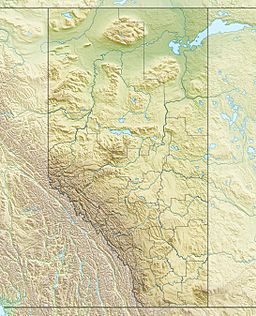Long Lake (Athabasca County) facts for kids
Quick facts for kids Long Lake |
|
|---|---|
| Location | Athabasca County, Alberta |
| Coordinates | 54°34′44″N 113°39′19″W / 54.57889°N 113.65528°W |
| Basin countries | Canada |
| Max. length | 8.3 km (5.2 mi) |
| Max. width | 0.8 km (0.50 mi) |
| Surface area | 1.62 km2 (0.63 sq mi) |
| Average depth | 9.4 m (31 ft) |
| Max. depth | 28 m (92 ft) |
| Surface elevation | 695 m (2,280 ft) |
Long Lake is a beautiful lake located in Athabasca County, Alberta, Canada. It's a natural body of water that plays an important role in the local environment. This lake is known for its long, narrow shape, which gives it its name.
Contents
Discover Long Lake's Location and Size
Long Lake is found in the central part of Alberta. It is about 695 meters (2,280 feet) above sea level.
How Big is Long Lake?
Long Lake is quite long, stretching about 8.3 kilometers (5.2 miles). However, it's not very wide, only about 0.8 kilometers (0.5 miles) across. The total area of the lake is about 1.62 square kilometers (0.63 square miles).
How Deep is Long Lake?
The average depth of Long Lake is around 9.4 meters (31 feet). But in some spots, it can get much deeper, reaching a maximum depth of 28 meters (92 feet). This makes it deep enough for various types of aquatic life.
Why Are Lakes Like Long Lake Important?
Lakes are vital parts of our planet's ecosystem. They provide homes for many plants and animals. They also offer places for people to enjoy nature and outdoor activities.
Nature and Wildlife at the Lake
While specific details about Long Lake's wildlife are not listed, lakes in Alberta generally support a variety of fish, birds, and other animals. You might find different types of fish, waterfowl like ducks and geese, and even larger animals like moose or deer near the shores. The plants in and around the lake also help keep the water clean and provide food and shelter for animals.
Fun Activities at Long Lake
Lakes like Long Lake are great places for recreation. People often visit lakes for activities such as fishing, boating, canoeing, and swimming during the warmer months. In winter, if the ice is thick enough, activities like ice skating or ice fishing might be possible.


